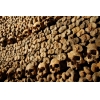|
 The
Catacombs of Paris (the
«municipal Ossuary») have been created at the end of
the 18th century. Hundreds of kilometers of mysterious galleries also known as French
catacombs there as ancient stone quarries, the place that provided construction
materials for mediaeval city residents to erect cathedrals and luxury palaces
for the grand people. Then the catacombs turned into the enormous cemetery
which is the place of burial for more people than those who live in the Paris conurbation
currently. The
Catacombs of Paris (the
«municipal Ossuary») have been created at the end of
the 18th century. Hundreds of kilometers of mysterious galleries also known as French
catacombs there as ancient stone quarries, the place that provided construction
materials for mediaeval city residents to erect cathedrals and luxury palaces
for the grand people. Then the catacombs turned into the enormous cemetery
which is the place of burial for more people than those who live in the Paris conurbation
currently.
These
included Pere Lachaise presented as the enormous cemetery for the Saints
Innocents in Paris
leading to the removal of all human remains from 1785. The ossuary was
consecrated on April 7, 1786. The Paris Catacombs were abandoned stone quarries
once populated by thieves and the homeless. The skeletal remains and all bones were
sorted and stacked neatly by type and modeled after the example set by Rome. The Catacombs
became a popular innovation for the old nobility who had their dinner parties
and picnics underground in the Paris Catacombs.
Very often the
visitor is not aware at all that they are 20 meters deep into the
earth when going down to the stretched narrow galleries that come to the ossuary.
Thereabouts the lowering there isthe bottom for the aqueduct Arcueil. With the head above, the visitor can see the traces
of the ancient works and the black line on the arches of the quarry, «Ariadne's
clew», that allowed walking in catacombs to orient themselves. Then the zone goes
to the area of so called studio that is the part of the quarry that has not
undergone sea changes from that time. The turned columns were the support for
the arch. In the past time the place of burial was decorated with the reproductions
of sculptures and bás-relieves of Port Mahon, principal city of Minorque to the Balearic Islands.
There is nothing left from the sculptures at the moment though the bás-relieves
remained that were made by a quarryman called Décure, of the General Inspection
of the Quarries, veteran of the armies of Louis XV.
The ossuary
is the galleries of 780m long making a circle that is inserted in the square of Alles, Dalles, d'Alamber and Avenue René
Coty. When visiting the place, the traveler will see the variety of monuments and
the sanctuary placed in the so called sepulchral vault and the tunnel that some
time back was functioning to feed fresh air. The visit ends with the Inspection
Gallery laid under the rue Rémy Dumoncel where the well is showed that helped
to mine limestone for Paris.
The ladder
goes to the exit that is by the 36th house in the Rémy Dumoncel Street.
All in all,
the remains of over million people are buried here, and it is evident that the
expertise made by the specialists to investigate skeletons is far too
ineffective, whereas the statistical figures come to the approximate values.
|